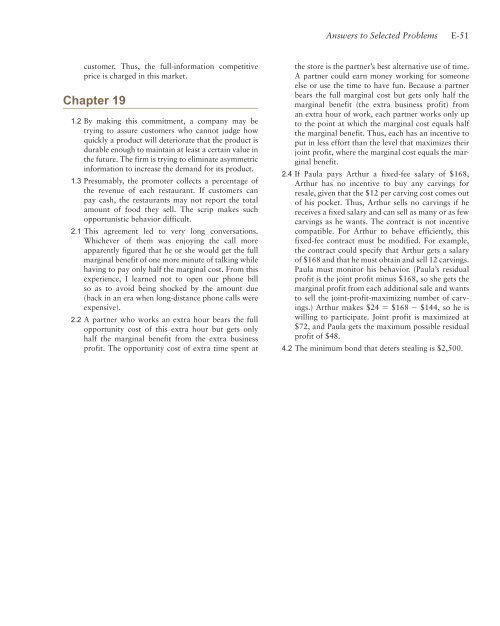Answers to Selected Problems
Answers to Selected Problems
Answers to Selected Problems
You also want an ePaper? Increase the reach of your titles
YUMPU automatically turns print PDFs into web optimized ePapers that Google loves.
cus<strong>to</strong>mer. Thus, the full-information competitive<br />
price is charged in this market.<br />
Chapter 19<br />
1.2 By making this commitment, a company may be<br />
trying <strong>to</strong> assure cus<strong>to</strong>mers who cannot judge how<br />
quickly a product will deteriorate that the product is<br />
durable enough <strong>to</strong> maintain at least a certain value in<br />
the future. The firm is trying <strong>to</strong> eliminate asymmetric<br />
information <strong>to</strong> increase the demand for its product.<br />
1.3 Presumably, the promoter collects a percentage of<br />
the revenue of each restaurant. If cus<strong>to</strong>mers can<br />
pay cash, the restaurants may not report the <strong>to</strong>tal<br />
amount of food they sell. The scrip makes such<br />
opportunistic behavior difficult.<br />
2.1 This agreement led <strong>to</strong> very long conversations.<br />
Whichever of them was enjoying the call more<br />
apparently figured that he or she would get the full<br />
marginal benefit of one more minute of talking while<br />
having <strong>to</strong> pay only half the marginal cost. From this<br />
experience, I learned not <strong>to</strong> open our phone bill<br />
so as <strong>to</strong> avoid being shocked by the amount due<br />
(back in an era when long-distance phone calls were<br />
expensive).<br />
2.2 A partner who works an extra hour bears the full<br />
opportunity cost of this extra hour but gets only<br />
half the marginal benefit from the extra business<br />
profit. The opportunity cost of extra time spent at<br />
<strong>Answers</strong> <strong>to</strong> <strong>Selected</strong> <strong>Problems</strong><br />
E-51<br />
the s<strong>to</strong>re is the partner’s best alternative use of time.<br />
A partner could earn money working for someone<br />
else or use the time <strong>to</strong> have fun. Because a partner<br />
bears the full marginal cost but gets only half the<br />
marginal benefit (the extra business profit) from<br />
an extra hour of work, each partner works only up<br />
<strong>to</strong> the point at which the marginal cost equals half<br />
the marginal benefit. Thus, each has an incentive <strong>to</strong><br />
put in less effort than the level that maximizes their<br />
joint profit, where the marginal cost equals the marginal<br />
benefit.<br />
2.4 If Paula pays Arthur a fixed-fee salary of $168,<br />
Arthur has no incentive <strong>to</strong> buy any carvings for<br />
resale, given that the $12 per carving cost comes out<br />
of his pocket. Thus, Arthur sells no carvings if he<br />
receives a fixed salary and can sell as many or as few<br />
carvings as he wants. The contract is not incentive<br />
compatible. For Arthur <strong>to</strong> behave efficiently, this<br />
fixed-fee contract must be modified. For example,<br />
the contract could specify that Arthur gets a salary<br />
of $168 and that he must obtain and sell 12 carvings.<br />
Paula must moni<strong>to</strong>r his behavior. (Paula’s residual<br />
profit is the joint profit minus $168, so she gets the<br />
marginal profit from each additional sale and wants<br />
<strong>to</strong> sell the joint-profit-maximizing number of carvings.)<br />
Arthur makes $24 = $168 - $144, so he is<br />
willing <strong>to</strong> participate. Joint profit is maximized at<br />
$72, and Paula gets the maximum possible residual<br />
profit of $48.<br />
4.2 The minimum bond that deters stealing is $2,500.
















